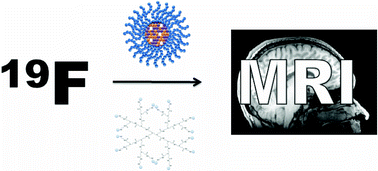The development of medical imaging probes for magnetic resonance imaging (MRI) is a particularly dynamic area of research. At present, many prominent groups are dedicating significant resources to tailoring and optimising the performance of potential contrast agents. Whilst 1H MRI has become an indispensable tool for the imaging of disease states, it frequently suffers from low contrast owing to background signal from intrinsic 1H. As a result, increasing attention is being directed at compounds containing 19F as this nucleus has a similar NMR sensitivity to 1H and, importantly, intrinsic 19F signals are virtually undetectable in vivo. For several decades, perfluorinated molecules (in which all of the C–H bonds in the parent molecule have been replaced with C–F bonds) and highly fluorous gases such as SF6 have traditionally been used for these kinds of investigations and there have been some excellent reviews of these compounds and their applications. However, recently 19F imaging is showing signs of evolution, particularly as there have been several reports of fluorinated responsive (smart) agents, micelles, dendrimers and hyperbranched polymers being investigated as targets for 19F-MRI. Furthermore, examples of multimodal contrast agents containing 19F nuclei are also starting to emerge. In this review we aim to summarise these exciting recent chemical developments.

You have access to this article
 Please wait while we load your content...
Something went wrong. Try again?
Please wait while we load your content...
Something went wrong. Try again?


 Please wait while we load your content...
Please wait while we load your content...